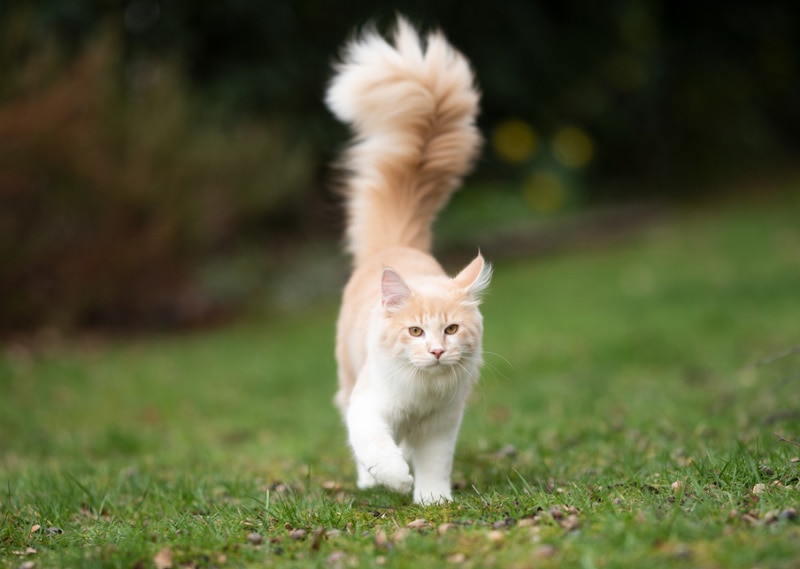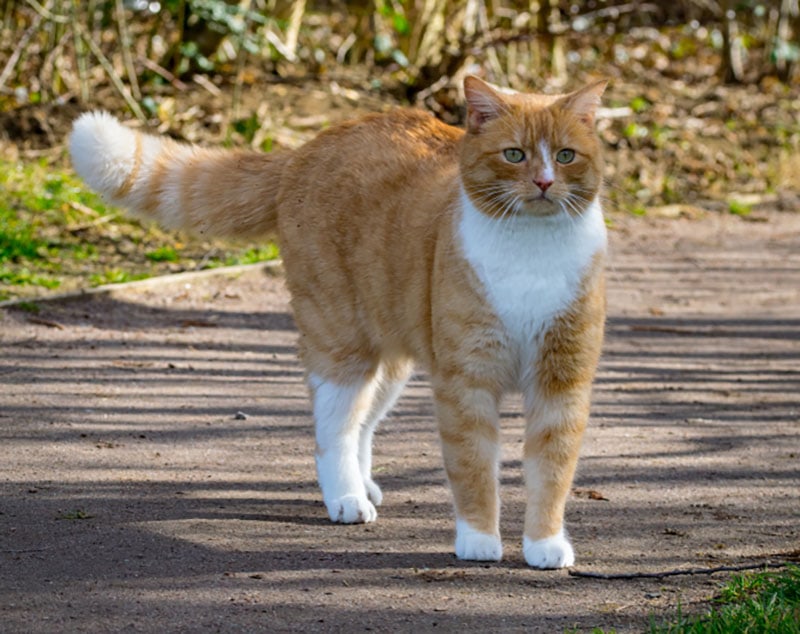Cat Tail Language: Vet-Approved Guide to What Your Cat Is Telling You
Updated on

Click to Skip Ahead
Cats may be unable to talk to us with words, but they have their own special way of communicating with humans. Your pet’s tail and movements can tell you a lot about her feelings and thoughts. If you’re scratching your head and wondering what your cat could be feeling, one glimpse at her tail can provide you with valuable insight.
Read on to learn more about deciphering your cat’s tail body language.
The 5 Tail Activities to Take Note Of
How your cat moves her tail will tell you a lot about her mood and feelings. Here are some tail movements that you should be aware of:
1. Whipping or Thrashing
A tail whipping aggressively back and forth can indicate that your cat is feeling fear or aggression. The same rule applies if your cat thumps her tail on the ground. Take this tail position as a warning and give her some space.

2. Gentle Swishes
If your kitty’s tail is swaying from side to side, it often indicates that she is focused on something. You may notice her tail taking this position when she’s about to pounce on her “prey” (AKA her favorite toy). Engaging in predatory behavior like stalking and pouncing provides fantastic enrichment for your kitty, so let her continue engaging with her toys to promote happiness and healthfulness.
3. Quivering
When your pet’s tail is quivering, she’s trying to tell you she’s excited to see you or another cat. However, some cats will urine-mark or pseudo urine-mark when their back ends are up against a vertical surface (like a wall), and their tails are quivering, so take note of your kitty’s body language to determine whether she’s excited to see you or if she’s urine-marking.

4. Twitching
You may see your cat’s tail twitching when she’s looking out the window at a bird or about to pounce on her favorite toy. A twitching tail typically means your kitty is very focused and concentrated on the task, whether diligently “guarding” your home from birds or hunting her favorite toys.
5. Puffed Up
A puffed-up tail may be adorable, but it signifies an extremely afraid or agitated kitty. You’ll likely notice your cat sporting a puffy tail if she’s having a showdown with another cat in the home or seeing another animal outside encroaching on her territory.

The 6 Tail Positions to Take Note Of
It’s not just the motion of your kitty’s tail you should pay attention to, as how your pet is holding her tail can tell you a lot about her mood.
1. High
A cat that’s holding her tail high is expressing confidence and contentment. A tail sticking straight up into the sky generally tells the world she’s happy and friendly.

2. Curved
A tail with a curve like a question mark may signify a cat ready to play. Don’t be surprised if your cat suddenly launches into her daily zoomies after seeing her with a curved tail.
3. Low
A kitty with her tail held low or straight down may feel stressed or aggressive. This tail position typically signifies a serious mood.

4. Tucked Away
If your kitty has positioned her tail so that it’s tucked underneath her body, she may be feeling afraid or submissive. Chances are there’s something in her environment that’s making her nervous.
5. Wrapped Around You or Another Cat
When your cat wraps her tail around you or other cats in the household, she shows that she cares deeply for you and is relaxed. This tail position typically means she’s open to pets and receiving your human contact.

6. Wrapped Around Herself
A cat that wraps herself in her own tail could be trying to tell you several things.
Sometimes cats wrap their tails around themselves when relaxing or settling in for a nap. While a tail wrapped around you means she’s receptive to snuggles, when it is wrapped around the cat, it typically means she’s not currently interested in interaction.
If your kitty is curling her tail around herself, she could be feeling defensive, frightened, or unwell.
If she’s found crouching with her tail curled tightly around herself for more than a day or two, you should have her evaluated by a veterinarian to rule out any illnesses.
Why Does My Cat Chase Her Tail?
Tail chasing is a normal behavior often seen in kittens and young cats. Your sweet baby is a hunter, after all, and what better way to practice her hunting skills than by pouncing on her tail and spinning in circles over it?
Adult cats occasionally chase their tails for entertainment, especially if they often exhibited this behavior as kittens. However, since most adults grow out of such behaviors, it is important to pay close attention if your older cat suddenly starts chasing her tail.
While she may be doing it out of boredom or to relieve stress, it could be indicative of an underlying health issue. Your cat may not be chasing her tail for fun but instead reacting to pain or itchiness from infections or allergies.
Rarely, cats can develop a condition known as feline hyperesthesia syndrome (FHS). FHS is marked by an extreme sensitivity in an area of the skin, often the area right in front of the tail. In addition to suddenly chasing their tail, cats with FHS may exhibit signs such as rippling skin after being touched and for no apparent reason, excessive vocalizations, biting the lower back or tail, dilated pupils, and running around the house without cause.
Final Thoughts
While your cat can’t use words to tell you what she’s thinking or how she’s feeling, her tail movements and positions can tell you a lot. Pay close attention to how your cat moves her tail and what other behaviors she’s exhibiting to gain insight into her mood and emotions.
Featured Image Credit: Nils Jacobi, Shutterstock














